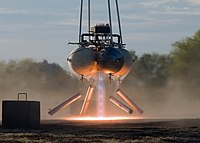
Photo from wikipedia
High frequency (MHz-order) surface acoustic waves (SAW) are able to generate intense fluid flow from the attenuation of acoustic radiation in viscous fluids as acoustic streaming. Though such flows are… Click to show full abstract
High frequency (MHz-order) surface acoustic waves (SAW) are able to generate intense fluid flow from the attenuation of acoustic radiation in viscous fluids as acoustic streaming. Though such flows are known to produce a force upon the fluid and an equivalent and opposing force upon the object producing the acoustic radiation, there is no convenient method for measuring this force. We describe a new method to accomplish this aim, noting the potential of these devices in providing essentially silent underwater propulsion by virtue of their use of the sound itself to generate fluid momentum flux. Our example employs a 40 MHz SAW device as a pendulum bob while immersed in a fluid, measuring a 1.5 mN propulsion force from an input power of 5 W power to the SAW device. Supporting details regarding the acoustic streaming profile via particle image velocimetry and an associated theoretical model are provided to aid in the determination of the propulsion force knowing the applied power and fluid characteristics. Finally, a simple model is provided to aid the selection of the acoustic device size to maximize the propulsion force per unit device area, a key figure of merit in underwater propulsion devices. Using this model, a maximum force of approximately 10 mN/cm2 was obtained from 1 W input power using 40 MHz SAW in water and producing a power efficiency of approximately 50%. Given the advantages of this technology in silent propulsion with such large efficiency and propulsion force per unit volume, it seems likely this method will be beneficial in propelling small autonomous submersibles.
Journal Title: Micromachines
Year Published: 2020
Link to full text (if available)
Share on Social Media: Sign Up to like & get
recommendations!